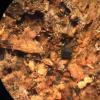
22-12-2025 00:47
Patrice TANCHAUDBonsoir, récolte à proximité du milieu dunaire

21-12-2025 21:32
Pol DebaenstHello, Garden, Burgweg 19, Veurne, BelgiumOn 10/1

21-12-2025 21:40
Isabelle CharissouBonjour, j'aimerais connaitre les références de

21-12-2025 21:31
Pol DebaenstHello, Garden, Burgweg 19, Veurne, BelgiumOn 10/1

21-12-2025 21:31
Pol DebaenstHello, Garden, Burgweg 19, Veurne, BelgiumOn 10/1

20-12-2025 23:08
Patrice TANCHAUDBonsoir, récolte sur sol sablonneux dans l'arri�

21-12-2025 09:32
Hello.A tiny ascomycete found embedded in wood in

20-12-2025 15:47
Mirek GrycHi.These grew on pine wood that was heavily covere
Claussenomyces sp.?
Bigelow Tom,
08-07-2017 02:06
Hans-Otto Baral,
08-07-2017 08:52

Re : Claussenomyces sp.?
Dear Tom
interesting observation but more data are necesary to help here.
You say the largest apos are 3 mm. With a razor blade you should easily make a median section to show the excipulu. Is it brown or hyaline? Cell shape? Where is it gelatinous?
Did you test Lugol for the ascus apex?
Do you have images of the anamorph too?
At present I have no idea for a genus.
Zotto
interesting observation but more data are necesary to help here.
You say the largest apos are 3 mm. With a razor blade you should easily make a median section to show the excipulu. Is it brown or hyaline? Cell shape? Where is it gelatinous?
Did you test Lugol for the ascus apex?
Do you have images of the anamorph too?
At present I have no idea for a genus.
Zotto






